2-11-24
The Monk and the Gun: Pawo Choyning Dorji, Untier of Knots
By Diane Sippl
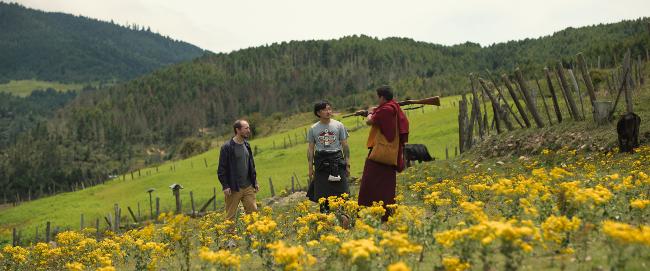
Pawo Choyning Dorji appears to be a rising star on the map of world cinema. Having written, directed, and produced two feature films, he has seen both of them represent his country, Bhutan, at the Academy Awards. His debut, Lunana, A Yak in the Classroom (2019), ended up nominated at the Oscars for Best International Feature Film. His second theatrical film, The Monk and the Gun (2023) was also short-listed in the same competition of more than 90 films in that category from around the world.
The filmmaker introduces his work with this background:
The Monk and the Gun captures the wonder and disruption as Bhutan becomes one of the world’s youngest democracies. Known throughout the world for its extraordinary beauty and its emphasis on Gross National Happiness, the remote Himalayan Kingdom of Bhutan was the last nation to connect to the internet and television. And if that weren’t enough change, the King announced shortly afterwards that he would cede his power to the people via their vote and a new form of government: Democracy.
An elderly lama (Kelsang Choejey), recognizing that extraordinary change is about to sweep through his country, is troubled by the possible outcomes. He instructs his young disciple Tashi (Tandin Wangchuk) to set forth into the kingdom and bring him two guns before the full moon to “set it right.” The young monk is perplexed by his guru’s request, and his familiarity with guns is based solely on images from the only film available on television: one from the James Bond series. His quest brings him into contact with a scheming American gun collector Ron (Harry Einhorn), leading to a most unexpected outcome.
Ura, the principal location of The Monk and the Gun, is a rural village, but with access to modern amenities like electricity and motorable roads. We have no camera and lighting equipment in Bhutan, so our rented gear had to come all the way from New Delhi, India, and it took a week of driving for it to reach our principal location.
For both my films’ productions, I have tried to take what might be seen as a challenge and turn it into an asset. Since there aren’t any professional actors in Bhutan, I try and cast my actors very early in pre-production so that I may have time to rehearse the scenes with them, but also so that I can learn of the different nuances and characteristics of the cast and then implement them into the characters of the script, so that they are being more themselves than acting in the film. The Lama (Buddhist teacher) in the movie is the actual and only Lama of the village.
Bhutan, as with any other country, is on a relentless quest to become modern, educated and western. Many times, in this quest, we shed our own culture that makes us so very unique. These values are more or less disappearing in urban Bhutan, such as in the city of Thimphu, so I went into rural Bhutan to highlight our spiritual traditions. These encompass innocence. Innocence is a such an important theme of being Bhutanese. Sadly, as we change, this beautiful value is getting lost because it seems the modern mind cannot differentiate between ‘innocence’ and ‘ignorance’.
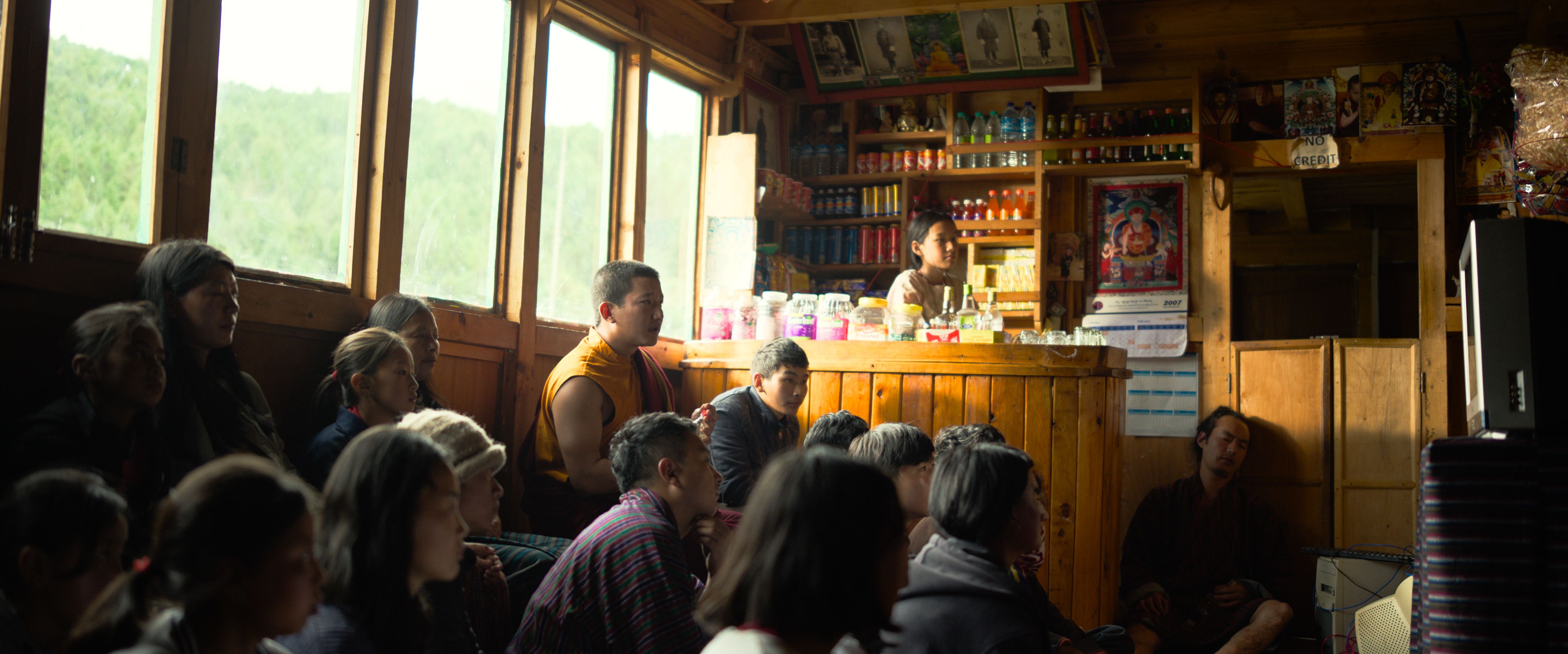
Buddhism in Bhutan is not just a spiritual path, but a way of life. The teaching of the Buddha influences every aspect of Bhutanese culture and traditions. Keeping that in mind, the monks, who are seen as the physical representations of the Buddha’s teachings, are objects of immense respect, veneration, and devotion in Bhutan. For example, there is so much respect for the ordained that the rural people don’t even seem to question or flinch at the audacity of a monk with a gun, because there is so much trust that stems from the Buddha’s teachings: ‘the motivation behind an act is much more important than the act itself’. I also want to highlight the value of symbolism in Bhutanese culture, how the symbolic power of items can at times be even more important than the item itself.
Throughout modern history, the existence of the tiny Bhutan depended on its ability to stay irrelevant. The policy of Self Isolation helped Bhutan survive and withstand colonialism and foreign influence, while its neighbors Tibet and Sikkim lost their independence. As the rest of the world embraced the trends of globalization, such as Coca-Cola, McDonald’s, MTV and democracy, Bhutan stubbornly clung on to the safety nets of the past, with the King as the sole power of authority, and the 2,500-year-old teachings of the Buddha as a guide to how to live one’s life. As the world entered the digital age, the Bhutanese chose to shun the internet, cell phones and cable TV, to safeguard our own unique way of life.
However, around the mid-2000s, when the film takes place, Bhutan found its own existence under threat as it found itself left behind in a digital politicized world. Yet Bhutan is probably one of the only countries where a system of democracy was introduced without any demand or revolution of the masses calling for it, introduced by a King who voluntarily abdicated so that his country and people could find their own unique place in the world.
Bhutan’s democracy is still in its infancy, and we are still getting accustomed to it. Naturally, there are still many instances of people learning to disagree with one another, something that is very alien to our culture. In a culture where the sense of community is deeply rooted, the advent of individualism and individualistic ideologies has been and can continue to cause unease.
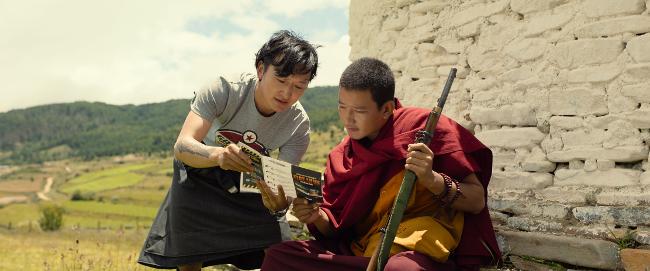
What follows are excerpts from a post-screening Q&A in Los Angeles on January 12, 2024 with Pawo Choyning Dorji moderated by Peter De Bruge from Variety magazine and some responses to questions from the audience.
I Could See My Eyelashes
Before he had ever made a feature film in his home country of Bhutan, Pawo Choyning Dorji, the son of a diplomat, lived abroad in Switzerland, the Middle East, and even neighboring India. He also attended Lawrence University in Appleton, Wisconsin. Thus, he recounts his changing experiences with the concept of “democracy”:
Bhutan is in the Himalayas, but I was always left with only one day of snow there. People warned me about the winter in Wisconsin, but I thought nothing of it. It snowed for seven months. I used to have icicles form on my eyelashes… But still, I think studying politics in a liberal arts college in the Midwest really gives you a glimpse of the American system. And I distinctly remember I was there when the king (of Bhutan) abdicated. I used to be someone who tried to keep a low profile in class, and that day my Political Philosophy professor, Professor Woolf, stormed into class. He was like, ‘Machiavelli, right, and The Prince—the philosopher king has to accumulate his power, his authority, and at the peak of his power, gives it up for democracy. That’s a philosopher king. And he said, ‘It never happened in the world until today in the Himalayan kingdom of Bhutan!’
Suddenly the spotlight was on me, and everyone turned to me. Growing up outside the country, I think I got a very objective view of the changes happening in Bhutan. In Buddhism, there’s a beautiful saying that one can never see one’s eyelashes because eyelashes are so close. So I was a Bhutanese who was outside, and far enough, yet inside, so that I could see my eyelashes and appreciate the changes that were happening, and of course studying politics in the U.S., seeing democracy.
Ignorance vs. Innocence
I remember at that time, Sadam’s statue had toppled in Baghdad, and all these college students in Wisconsin were saying, ‘Oh, we’re going to liberate these people,’ you know—and I could see the value of democracy, and how it was being implemented in Bhutan, and yet the people in Bhutan had no idea about it, and were saying ‘We don’t want this. What is this strange gift that the king is giving us? We don’t want this.’
My multi-national, multi-cultural upbringing has kept me in tune with all the cultures that I grew up with, and the films I make, I think, without myself knowing it, are kind of influenced by that. So for example, when I was writing the script I was like, ‘Oh—if a Bhutanese monk were to understand what the Second Amendment is, how would he put it?’ This film is made for the Bhutanese audience, but also, because of my upbringing, for the international audience, and something I find so magical about it is that, as it travels around, it seems almost to become a mirror upon which each culture, each people, sees a reflection of what they hold dear.
In North America as the film premiered in Telluride, Toronto, Vancouver, it’s been the political satire that people can relate to. In India, they seem to really like the comedy element. But the interesting thing is, when it screened in Bhutan—we had he premiere there in October—people were so emotional, crying, in the cinema, and when I came out I was saying, ‘It’s not supposed to make you cry—it’s supposed to be a comedy!’ But for the Bhutanese, I think, really could see that when we are in pursuit of something we think we need, we end up losing what we have. That difference between being innocent and being ignorant—that loss—I think the Bhutanese connected with that.
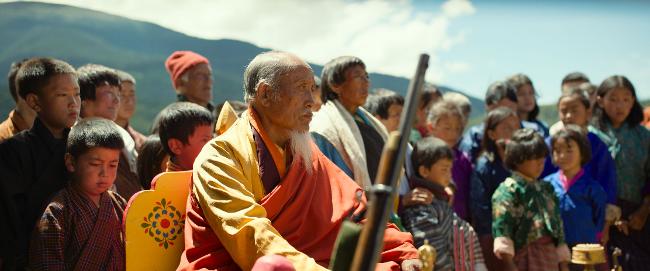
The West and the World
In commenting on the use in his film of Western popular culture and products that are being promoted world-wide, such as Coke-a-Cola and the James Bond film, Quantum of Solace, the director added,
There’s also MTV. The thing is for me, having spent time growing up outside, going back to Bhutan pre-2006 when there was no TV, no Internet, and seeing how the people were living there, I think I could really notice how these changes were impacting the people. Because all over the world, change, accepting these elements, has been a gradual process. There’s no one point in any country when they’re like, ‘Oh, that was the day and year when Internet came in.’ In Bhutan, we have that. The day when TV was first allowed—oh, it was a big celebration. The royal family came out, and they had these silk scarves—and the ‘Power On’ button, and the TV comes on, and everyone is cheering, Buddhist prayers are being chanted—we have that.
And when the change comes and is that drastic, and that sudden, then the way you accept this change and the reaction to it is also that drastic. Everything you saw in this film is based on true stories. Yes, we did have a mock election. Yes, the Yellow Party won. Also, yes, people sold their cows for TVs, because all of a sudden, having a TV set became a status symbol. That happened. People sold their cows, sold their land, to have a TV set. When TVs came in, they had processions.
James Bond, yes, but people like David Beckham, Eminem, overnight became cultural icons. And just as you all saw, they took down the posters of the leaders and replaced them with these pop icons. It got so bad that the Bhutanese government actually had to ban WWF wrestling, pro wrestling, because all of a sudden, all these village boys got to fighting… and this is not good.
Regarding the inclusion of James Bond, I needed something to connect the monk to the gun, and it was a long process, to be frank. At first, I wanted Rambo—Sylvester Stallone with a red bandana and with his ripped muscles and carrying a rocket launcher—that was something all Bhutanese my age at that time were like, ‘Wow-w-w’—that’s what we want to be like!’ But it proved very difficult to get the rights for that—Sylvester Stallone was not interested.
The one thing you have to realize is that it was all so sudden; when it comes so suddenly, the reaction, the impact it has, is also so sudden. When I wrote the script and I added the gun, I wanted the gun to symbolize the coming of modernization. So yes, there are benefits to it, but it can also cause a lot of suffering. And of course, a gun is not made in Bhutan; it’s a very foreign element coming in. So the gun symbolizes the coming of modernization, and when I was working with the monk, I was telling him, ‘I want you to embrace the gun just as the Bhutanese are embracing modernization, very innocently. So, yea, look inside the barrel, hold it upside down, use it like a walking stick—you don’t know what it is.
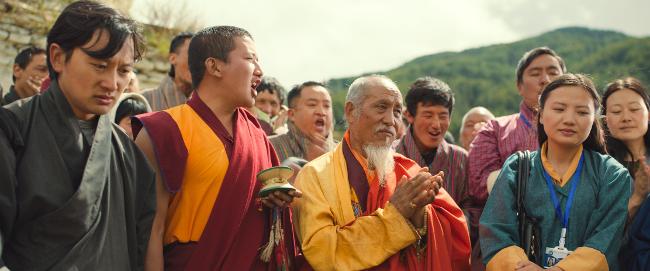
Put Water Inside Your Ear
Counter to that, I needed something to then symbolize the Bhutanese culture, the Bhutanese tradition, and that’s where the phallus comes in. We are the last Vashrayana kingdom, the last Vashrayana Bhuddhist country in the world, and in the Vashrayana tradition, the best solution to a problem is a solution that is the problem itself. So if you have water in your ear, the Vashraya Buddhist would be like, ‘Put water inside your ear, the water will come out.’
So in Bhutan, being a Buddhist country, the ultimate goal of the state, of the people, of the leader, of the king, is the state of enlightenment. And what is the biggest obstacle to enlightenment? Inhibition. Having dualistic thought. Having conflict. So in our tradition, if you have inhibition, how do you get rid of it? By giving more inhibition. So, you see a phallus? You feel uncomfortable? Well, in the Bhutanese way, we’ll keep showing you a phallus until you realize that the phallus is non-inhibiting, inhibition is non-existent, and you reach enlightenment.
So when I grew up as a child in Bhutan, phalluses were everywhere. You’re inaugurating a building? Okay, hang a wooden phallus on the doorway. You have a shopping mall? Okay, paint a phallus on the wall so it will ward off evil spirits. We grew up like that. But interestingly, post-2006, as we modernized, and we opened ourselves up to the outside world, that innocence was thought as being ignorant. So suddenly, the phallus that was the symbol to destroy inhibition, became the cause of inhibition. Suddenly, the Bhutanese became embarrassed: ‘Oh, we have a big penis on our wall—what will the foreigners think of us? We’re so primitive. Whitewash it. Get rid of it.’ We became like that. So, in a way, I wanted to bring the phallus back into the movie to remind the Bhutanese, ‘Hey, this is our culture. This is our tradition. And we should be proud of it. We shouldn’t shun it.
And thus, we have the scene where the lama has the gun, and the phallus, and then Ron, who wants the gun, ends up with the phallus. But it’s interesting, because sometimes when this movie screens, people ask me, ‘Oh, you have a phallus, you have a gun—what masculine phallic symbols. Does that mean that Bhutan is a very patriarchal society? But it’s not. Bhutan is actually the most matriarchal society I know. And I’ve grown up all over the world. That’s why it’s Toma’s mother who calls the shots in the movie, because in Bhutanese society, it is the mother. When a bride and groom get married, the groom moves into the bride’s house. When a family land heirloom passes on, it goes to the eldest daughter, not to the son. So it’s actually the other way around.
Untying the Knot
As the cinematic ambassador of one’s country, is there a sense of responsibility?
Oh, definitely. I feel an enormous amount of weight on my shoulders because I think cinema is one of the most popular media to share—to tell stories. And I always tell people that in Bhutan, we don’t have a word for “storytelling.” It’s not because Bhutanese culture is primitive or we don’t have the necessary vocabulary for it, but it’s because storytelling forms such an important foundation of who we are—the culture that the Bhutanese people represent. So in Bhutan—when we say, in English it would be, ‘Peter, tell me a story’—in Bhutanese, it would be, ‘Peter, please untie a knot for me’. So the act of telling a story is supposed to have the purpose of un-tying, liberating, freeing. So I always call myself an ‘untier of knots’. This film, I always say, is untying the knot of innocence.
So for me, in terms of the responsibility of a filmmaker in my country, the Bhutanese film industry is practically non-existent. We’re lucky to have a film like this come out once every five to six years. And I have been incredibly lucky. I didn’t study film. I studied political science. I became a filmmaker because I loved watching films, I loved the power of cinema, and I decided to make Lunana, A Yak in the Classroom, which was made on solar batteries, up in the mountains. They say, ‘Never shoot animals and never shoot children,’ but I had a yak and six children who had never watched a film as my main cast. And the film got to where it was because many different people were willing to take a chance with it. It went from solar batteries up in the world’s most remote classroom to an Oscar nomination.
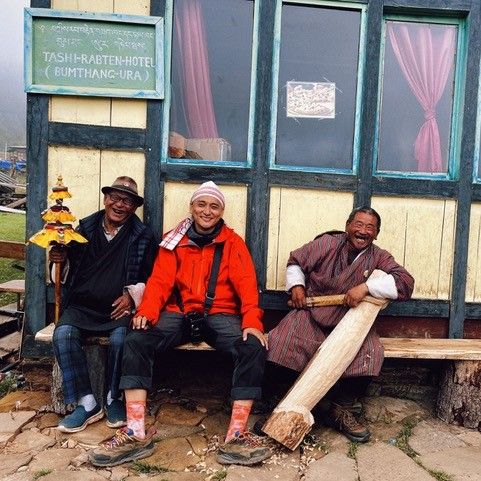
“Keep that Innocence”
So what was different in making The Monk and the Gun after Lunana, a Yak in the Classroom?
Everyone’s saying Lunana is a very simple story—it’s about one character, one storyline.’ I said, ‘Okay, let’s try and explore this. Let’s throw in all these characters, let’s throw in all these storylines. Let’s make it more of a comedy. And I think comedy’s very difficult; you either get it right, or it goes horribly wrong. So it was a risk that I was willing to take because I wanted to grow as a filmmaker. I wanted to experiment with these aspects, and I wanted to showcase different aspects of my culture, of my country, of my people, to the world.
Ang Lee once told me, ‘Pao, the way you tell stories, you tell it with a heart of innocence, and don’t lose that… My advice to you is, then, with every film you make, you keep that innocence, and you keep that heart of Lunana.’
You know, you make your first film, you get Oscar-nominated, suddenly you get all this attention, and you get all these people suggesting, ‘Oh, use this actor, use that actor.’ And yes, I admit, my head was turned by that at first—the idea of having a Hollywood actor in your film? I was like, ‘Wow! That sounds exciting!’ But then I remembered Ang Lee’s advice as well, and I thought, ‘Maybe this is not the time.’
I think we would be having a very different conversation if I had cast a professional Hollywood actor. It wouldn’t be this movie about change and transition and the loss of innocence; it would be about how this guy from Hollywood went and made a film in Bhutan. And also, I think the dynamics of the production would have been very challenging. How would I explain to my cast and crew that this actor, who had a very small role in the film, would be getting 95% of the budget?
For me, I take a lot of pride in working with non-professional actors. In Lunana and The Monk and the Gun, all the actors are non-professionals, including Harry, who plays Ron. And yes, there are challenges when you work with non-professional actors, but then also, I think, at this stage in my career, that was a decision that helped me, because there’s an authenticity that comes out, and I feel that in these films, when you have authenticity and performance come together in the middle ground, it becomes very realistic because it’s this magic that happens.
Lunana, a Yak in the Classroom did well internationally, and some of the countries where it did extremely well are Brazil and Japan, where it was in public cinemas for over a year. The film was also the highest-grossing film in Israel, even more than local Israeli films.
As Filmmakers, We Are Artists
An audience question: I’m graduating from film school in May, and I’m just wondering if you have any advice for getting on productions.
Yea, well, advice, on productions, I’m not sure, but something that I can share with you is that as filmmakers, we are artists, and I think that something that is fundamentally part of being an artist is rejection and failure, and I think that is never taught in film school. You’re taught to be creative, you’re taught to be successful, but they’ll never teach you how to face and how to deal with failure, rejection. I think my one bit of advice to you would be, ‘Know that this is part of the career. There is no success without failure.’
When I made Lunana, a Yak in the Classroom, I worked so hard on that mountain top with that solar battery to power my camera. I hadn’t taken a shower in two months. I made this film, and I was so keen to share it with the world, and for the first seven months I was just rejected by every film festival. And at that time, I wondered, ‘Am I actually doing the right thing?’
Then, of course, eventually, it picked up. And then I found myself an Oscar nominee. So I think I wouldn’t have had any other journey, because when you get the success, you know where you came from, and you remain grounded, and you accept that these things come together. So as you move forward, that’s something that I really cherished, and I think you should, too. Don’t give up. When you face failure, just keep that passion and keep telling stories. Keep untying knots.
The Monk and the Gun
Producer: Jean-Christophe Simon, Hsu Feng, Stephanie Lai, Pawo Choyning Dorji; Director: Pawo Choyning Dorji; Screenplay: Pawo Choyning Dorji; Cinematographer: Jigme Tenzing ; Editor: Hsiao-Yun Ku; Production Designer: Chungdra Gyeltshen; Sound: Tu Duu-Chih, Chiang Yi-Chen; Original Score: Frédéric Alvarez.
Cast: Tandin Wangchuk, Kelsang Choejey, Deki Lhamo, Pema Zangpo Sherpa, Tandin Sonam, Harry Einhorn, Choeying Jatsho, Tandin Phubz, Ugyen Dorji, Yuphel Lhendup Selden.
112 min., Color. In Dzongkha and English with English subtitles.